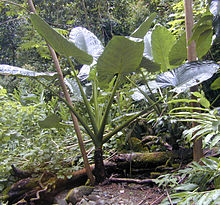Alocasia

Alocasia is a genus of broad-leaved rhizomatous or tuberous perennial flowering plants from the family Araceae. There are 97 accepted species[2] native to tropical and subtropical Asia to Eastern Australia, and many hybrids and cultivars widely cultivated around the world.
The large cordate or sagittate leaves grow to a length of 20 to 90 cm on long petioles. Their araceous flowers grow at the end of a short stalk, but are not conspicuous; often hidden behind the leaf petioles.
The corms of some species can be processed to make them edible, but the raw plants contain raphid or raphide crystals of calcium oxalate along with other irritants (possibly including proteases)[3] that can numb and swell the tongue and pharynx; they cause difficulty in breathing, and sharp pain in the throat.
The lower parts of the plant contain the highest concentrations of the poison. Prolonged boiling before serving or processing may reduce the risks, and acidic fruit such as tamarind may dissolve the raphides. However the species vary in toxicity, and it is dangerous to experiment with the edibility of any Alocasia.
